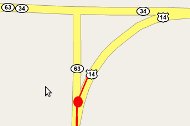Article from: www.thenewspaper.com/news/26/2686.asp
2/13/2009
South Dakota: State Takes no Blame for Creating Dangerous Intersection
South Dakota Supreme Court ruling absolves state officials from blame in maintaining dangerous conditions at intersections.
 The South Dakota Supreme Court on Wednesday issued a ruling absolving the state from any liability in cases where it fails to warn motorists on roadways with an inherently dangerous design. On February 13, 2004 two families were driving at the "Four Corners" intersection of Highways 14, 34 and 63. These roads merge together on a sharp curve in a blind crossing without a stop or yield sign. The two cars collided nearly head-on, taking the lives of three and severely injuring four others. The surviving family members sued Darren Griese, in his official capacity as South Dakota Department of Transportation (DOT) Pierre Region Traffic Engineer.
The South Dakota Supreme Court on Wednesday issued a ruling absolving the state from any liability in cases where it fails to warn motorists on roadways with an inherently dangerous design. On February 13, 2004 two families were driving at the "Four Corners" intersection of Highways 14, 34 and 63. These roads merge together on a sharp curve in a blind crossing without a stop or yield sign. The two cars collided nearly head-on, taking the lives of three and severely injuring four others. The surviving family members sued Darren Griese, in his official capacity as South Dakota Department of Transportation (DOT) Pierre Region Traffic Engineer.
The high court majority ruled that a state employee could not be held responsible for failing to maintain warning signs at the dangerous intersection because he was protected by sovereign immunity. The court reasoned that Griese had been operating as an expert with the discretion to post or not post signs as his personal judgment dictated. As long as no law required the posting of a sign, he was protected from any lawsuit.
"If the legislature or other policy maker has not demanded performance, the decision to act or not act is discretionary," Chief Justice David Gilbertson wrote for the 5-2 majority. "One can only imagine the reaction of an average citizen if he or she... were 'plucked off the street' and informed it was now his or her legal duty to place 'substantial and conspicuous warning signs' at any 'sharp turn, blind crossing or other point of danger...' How much stronger would their reaction be when they realize that the failure to place a sign in every conceivable place would result in their being subjected to suit and criminal charge simply based on a plaintiff's pleading disagreeing with the initial placement decision, and a jury being allowed to 'Monday morning quarterback' his or her conclusions..."
Justice Richard W. Sabers authored a scathing dissent that contended the duty to place signs at blind crossings was not only mandatory, it was a class one misdemeanor to fail to do so. The disagreement was so sharp that Gilbertson and Sabers took a number of personal jabs at each other. Sabers labeled the chief justice's reasoning "preposterous" and cited past cases authored by Gilbertson that appeared to disagree with his present ruling. Gilbertson, in turn, cited cases where Sabers appeared to hold an opinion opposite to the one he now held. Sabers set the case up for challenge before the US Supreme Court by asserting that the majority's decision violated the plaintiffs' Seventh Amendment right to a jury trial on the material facts involved in the case.
"Incredibly, under the majority's view, the highway department could arbitrarily, unreasonable and capriciously design the busiest, most dangerous intersection in South Dakota with inadequate signage or signage that goes out of repair, as here, and never be accountable, despite numerous injuries and deaths, year after year," Sabers wrote.
A full copy of the decision is available in a 1.4mb PDF file at the source link below.
Source: Truman v. Griese (South Dakota Supreme Court, 2/11/2009)
Permanent Link for this item
Return to Front Page
 The South Dakota Supreme Court on Wednesday issued a ruling absolving the state from any liability in cases where it fails to warn motorists on roadways with an inherently dangerous design. On February 13, 2004 two families were driving at the "Four Corners" intersection of Highways 14, 34 and 63. These roads merge together on a sharp curve in a blind crossing without a stop or yield sign. The two cars collided nearly head-on, taking the lives of three and severely injuring four others. The surviving family members sued Darren Griese, in his official capacity as South Dakota Department of Transportation (DOT) Pierre Region Traffic Engineer.
The South Dakota Supreme Court on Wednesday issued a ruling absolving the state from any liability in cases where it fails to warn motorists on roadways with an inherently dangerous design. On February 13, 2004 two families were driving at the "Four Corners" intersection of Highways 14, 34 and 63. These roads merge together on a sharp curve in a blind crossing without a stop or yield sign. The two cars collided nearly head-on, taking the lives of three and severely injuring four others. The surviving family members sued Darren Griese, in his official capacity as South Dakota Department of Transportation (DOT) Pierre Region Traffic Engineer.